SQL Server 2008 R2 – Serials
* DataCenter Edition
===================
PTTFM-X467G-P7RH2-3Q6CG-4DMYB
* Enterprise Edition
====================
GYF3T-H2V88-GRPPH-HWRJP-QRTYB
* Standard Edition
==================
MGWC3-RQP9V-7YWFK-HJF64-MBRQB
* DataCenter Edition
===================
PTTFM-X467G-P7RH2-3Q6CG-4DMYB
* Enterprise Edition
====================
GYF3T-H2V88-GRPPH-HWRJP-QRTYB
* Standard Edition
==================
MGWC3-RQP9V-7YWFK-HJF64-MBRQB
The matrices in this topic illustrate the compatibility between various versions of SQL Server software used for source, staging target, and provisioning target environments.
Source environments can be running any supported Windows operating system version. There are no compatibility requirements between the source environment’s operating system and that on the target environments.
The operating system version on the target environment that will contain the virtual databases should be equal to or higher than that on the staging target. For more information, see Overview of Setting Up SQL Server Environments.
| Provisioning Target Environment | ||||||
| Windows 2003 SP2/R2 | Windows 2008 | Windows 2008 R2 | Windows 2012 | Windows 2012 R2 | Windows 2016 | |
| Staging Target Environment | ||||||
| Windows 2003 SP2/R2 | X | X | X | X | X | X |
| Windows 2008 | X | X | X | X | X | |
| Windows 2008 R2 | X | X | X | X | ||
| Windows 2012 | X | X | X | |||
| Windows 2012 R2 | X | X | ||||
| Windows 2016 | X | |||||
The SQL Server version on the staging environment should be equal to that on the source environment.
| Staging Target Environment | ||||||
| SQL Server 2005 | SQL Server 2008 | SQL Server 2008 R2 | SQL Server 2012 | SQL Server 2014 | SQL Server 2016 | |
| Source Environment | ||||||
| SQL Server 2005 | X | |||||
| SQL Server 2008 | X | |||||
| SQL Server 2008 R2 | X | |||||
| SQL Server 2012 | X | |||||
| SQL Server 2014 | X | |||||
| SQL Server 2016 | X | |||||
When provisioning a VDB, the SQL Server version on the target should be equal to or higher than that on the source.
| Provisioning Target Environment | ||||||
| SQL Server 2005 | SQL Server 2008 | SQL Server 2008 R2 | SQL Server 2012 | SQL Server 2014 | SQL Server 2016 | |
| Source Environment | ||||||
| SQL Server 2005 | X | X | X | X | ||
| SQL Server 2008 | X | X | X | X | X | |
| SQL Server 2008 R2 | X | X | X | X | ||
| SQL Server 2012 | X | X | X | |||
| SQL Server 2014 | X | X | ||||
| SQL Server 2016 | X | |||||
Provisioning to Higher SQL Versions When the Source is SQL Server 2005
For SQL Server 2005, direct provisioning to higher SQL Server versions is only supported for provisioning to SQL Server 2012 or higher. You can first provision a VDB to SQL Server 2005 and then upgrade it to a higher version by following the steps outlined in the topic Upgrading SQL Server VDBs.
Delphix only supports 64-bit operating systems.
| Supported DBMS Version | SQL Server 2005 | SQL Server 2008 | SQL Server 2008 R2 | SQL Server 2012 | SQL Server 2014 | SQL Server 2016 | SQL Server 2017 | |
|---|---|---|---|---|---|---|---|---|
| Supported OS Version | ||||||||
| Win 2003 SP2 | Supported | Supported | Supported | N/A | N/A | N/A | N/A | |
| Win 2008 | Supported | Supported | Supported | Supported | Supported | N/A | N/A | |
| Win 2008 SP2 | Supported | Supported | Supported | Supported | Supported | N/A | N/A | |
| Win 2008 R2 | Supported | Supported | Supported | Supported | Supported | N/A | N/A | |
| Win 2008 R2 SP1 | Supported | Supported | Supported | Supported | Supported | N/A | N/A | |
| Win 2012 | N/A | Supported | Supported | Supported | Supported | Supported in 5.1.4+ | Not Supported | |
| Win 2012 R2 | N/A | Supported | Supported | Supported | Supported | Supported in 5.1.4+ | Not Supported | |
| Win 2016 | N/A | N/A | N/A | Supported in 5.1.8+ | Supported in 5.1.8+ | Supported in 5.1.7+ | Not Supported | |
Introduction
Replication is the process of sharing data between databases in different locations. Using replication, we can create copies of the database and share the copy with different users so that they can make changes to their local copy of database and later synchronize the changes to the source database.
Microsoft SQL Server replication uses publisher, distributor and subscriber entities.
Publisher is a server that makes the data available for subscription to other servers. In addition to that, publisher also identifies what data has changed at the subscriber during the synchronizing process. Publisher contains publication(s).
Subscriber is a server that receives and maintains the published data. Modifications to the data at subscriber can be propagated back to the publisher.
Distributor is the server that manages the flow of data through the replication system. Two types of distributors are present, one is remote distributor and the other one local distributor. Remote distributor is separate from publisher and is configured as distributor for replication. Local distributor is a server that is configured as publisher and distributor.
Agents are the processes that are responsible for copying and distributing data between publisher and subscriber. There are different types of agents supporting different types of replication.
An article can be any database object, like Tables (Column filtered or Row filtered), Views, Indexed views, Stored Procedures, and User defined functions.
Publication is a collection of articles.
Subscription is a request for copy of data or database objects to be replicated.
Types of Subscription:
Changes to the subscriptions at the publisher can be replicated to subscribers via PUSH subscription or PULL subscription. With Push subscription, the publisher is responsible for synchronizing all the changes to the subscriber without subscriber asking for those changes. With Pull subscription, the subscriber initiates the replication instead of the publisher.
Replication Types
Microsoft SQL Server 2000 supports the following types of replication:
Snapshot Replication
Transactional Replication
Merge replication
It allows making autonomous changes to replicated data on the Publisher and on the Subscriber. With merge replication, SQL Server captures all incremental data changes in the source and in the target databases, and reconciles conflicts according to rules you configure or using a custom resolver you create. Merge replication is best used when you want to support autonomous changes on the replicated data on the Publisher and on the Subscriber.
Replication agents involved in merge replication are snapshot agent and merge agent.
Implement merge replication if, changes are made constantly at the publisher and subscribing servers, and must be merged in the end.
By default, the publisher wins all conflicts that it has with subscribers because it has the highest priority. Conflict resolver can be customized.
Necessary steps to be taken before doing replication process:
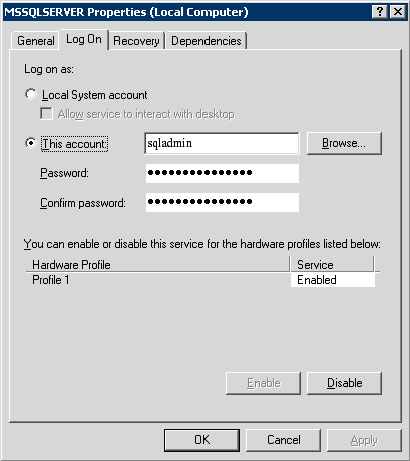
Step by Step Procedure for Merge Replication setup
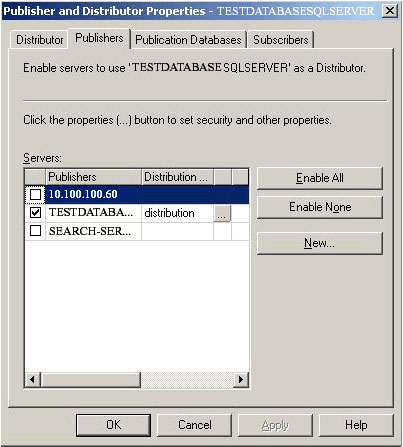

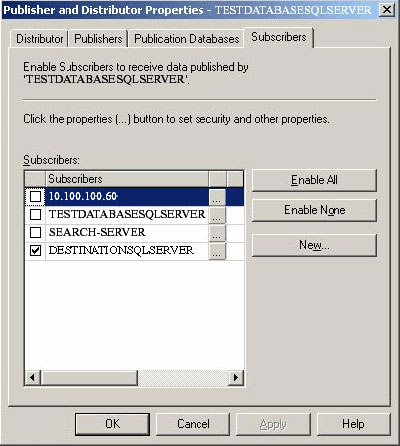
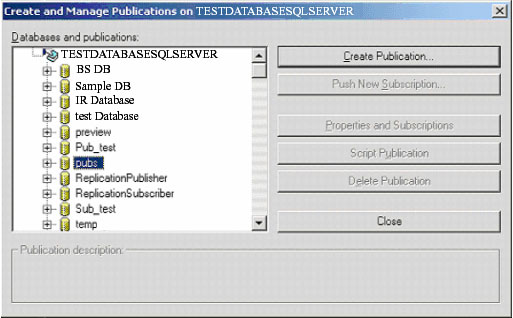
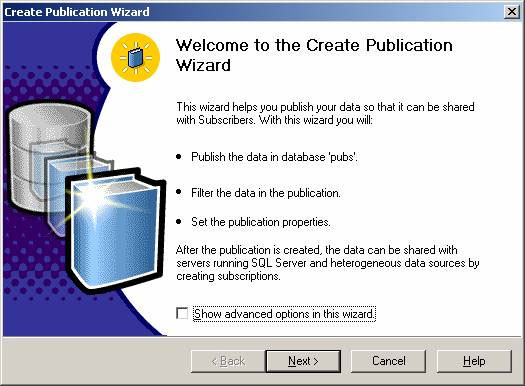
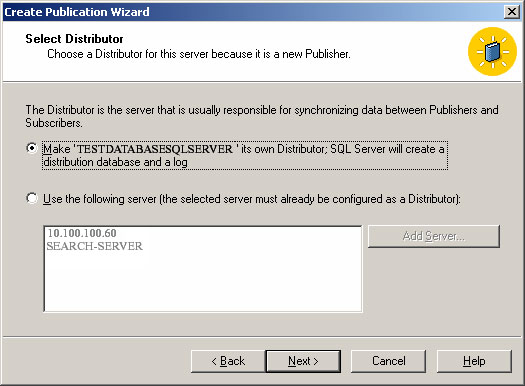
Note: Create one folder in the Publisher machine and share the folder, then give full permissions for the user through which you logged in. Make sure that you are able to access this folder from the Subscriber machine also. If you are not able to access, give full permissions to that shared folder for the appropriate user in the Publisher machine. The Snapshot folder should be in the Publisher machine.
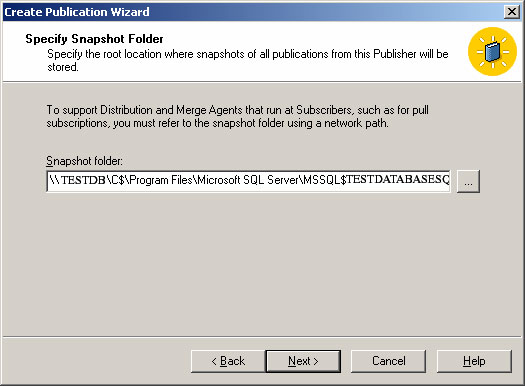
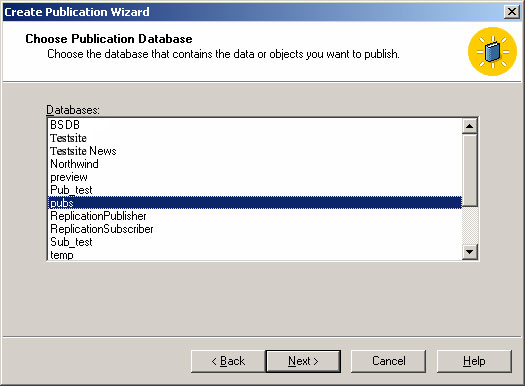
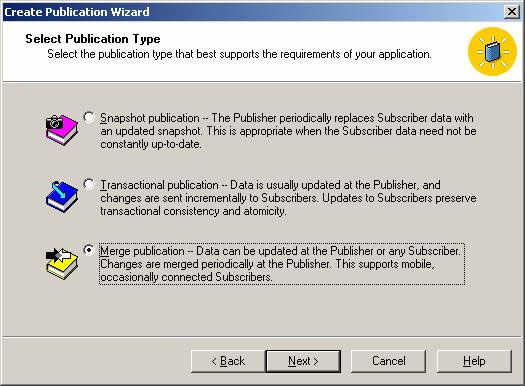

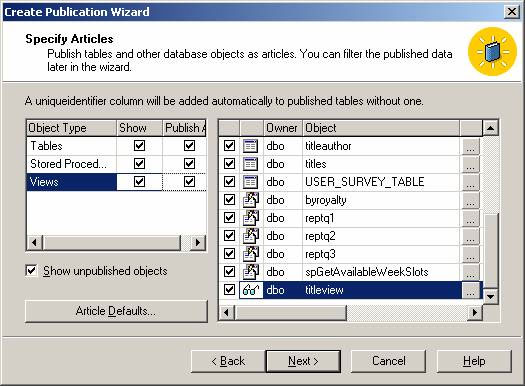
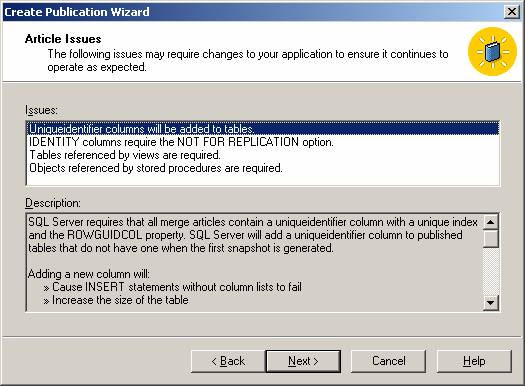

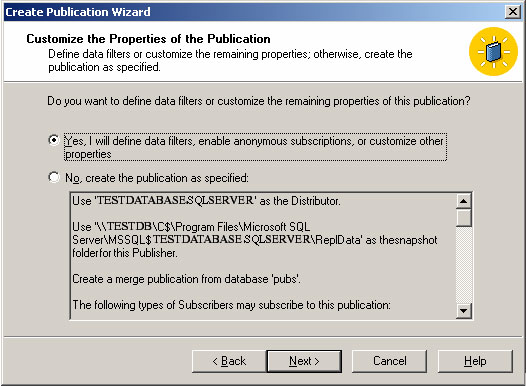
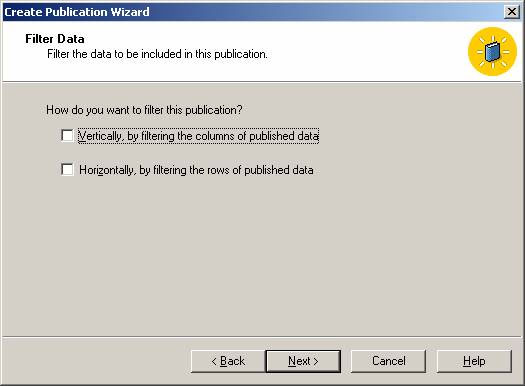
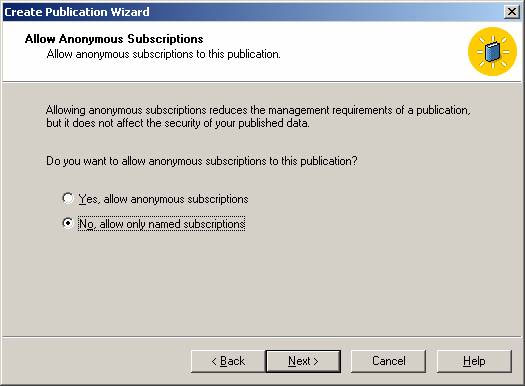
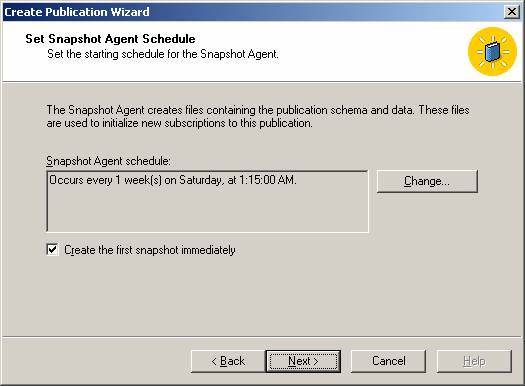

Important Note:
SQL Server 2000 replication will not support full-text indexing. But, enable full-text indexing at the subscriber machine manually. This can be done by Full-text indexing wizard. Select the appropriate table and enable the required fields in that table as full-text indexed. Then, create a new catalog or else use the existing catalog and schedule it, if needed. Once this is done, go to that particular catalog and right click and select “Start full population”. The status will be displayed as “population in progress”.
Advantages in Replication:
Users can avail the following advantages by using replication process:
Replication Performance Tuning Tips:
Conclusion
In a nutshell, replication is the capability to reliably duplicate data from a source database to one or more destination databases. SQL Server 2000 gives you the power for replication design, implementation, monitoring, and administration. This gives you the functionality and flexibility needed for distributing copy of data and maintaining data consistency among the distributed. You can automatically distribute data from one SQL Server to many different SQL Servers through ODBC (Open Database Connectivity) or OLE DB. SQL Server replication provides update replication capabilities such as Immediate Updating Subscribers and merges replication. With all the new enhancements to SQL Server replication, the number of possible applications and business scenarios is mind-boggling.